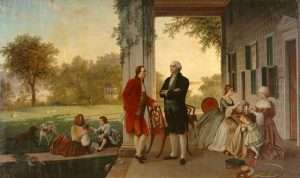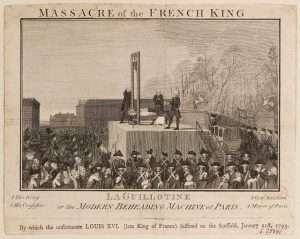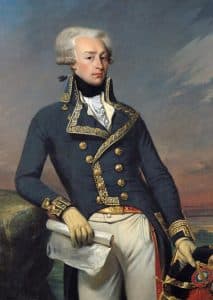| La Fayette, the Man of Two Revolutions |
Marquis de La Fayette, a name that resonates with valor and revolutionary zeal, played a pivotal role in shaping the destinies of both the United States and France. His unique position as a hero of two revolutions, the American Revolution and the French Revolution, sets him apart as a figure of immense historical significance. This article delves into the life, contributions, and enduring legacy of Marquis de La Fayette, the man who bridged two continents with his unwavering commitment to liberty and justice.
La Fayette Story
Early Life and Background
La Fayette was born on September 6, 1757, into an aristocratic family in Chavaniac, France. Orphaned at a young age, he inherited a substantial fortune and noble titles. His education, steeped in Enlightenment ideals, fostered a love for liberty and justice. These early influences would shape his destiny and drive his involvement in revolutionary causes.

La Fayette’s Role in the American Revolution
In 1777, captivated by the American struggle for independence, Lafayette defied the French king’s orders and sailed to America. He offered his services to the Continental Army without pay, embodying the spirit of altruism and dedication. La Fayette’s arrival was a morale booster for the American cause, and he quickly became a trusted ally and friend to George Washington and Benjamin Franklin.
The Battle of Brandywine
La Fayette’s first major engagement was the Battle of Brandywine on September 11, 1777. Despite being wounded, his bravery and tactical acumen shone through. His actions during this battle demonstrated his commitment and earned him the admiration of both American and French forces.
Winter at Valley Forge
The winter of 1777-1778 at Valley Forge was a period of great hardship for the Continental Army. La Fayette’s presence was instrumental in maintaining the troops’ morale and discipline. His leadership during these trying times helped strengthen the army, preparing it for future victories.
Victory at Yorktown
The Siege of Yorktown in 1781 was a decisive moment in the American Revolution. La Fayette’s strategic prowess was crucial in trapping British forces, leading to their surrender. This victory not only marked the end of major hostilities but also cemented Lafayette’s legacy as a key figure in America’s fight for independence.
La Fayette Return to France and Advocacy for American Interests
Upon returning to France, La Fayette was hailed as a hero. He continued to advocate for American interests, leveraging his influence to secure support for the new nation. His efforts were pivotal in fostering Franco-American relations, laying the groundwork for future alliances.

La Fayette and the French Revolution
La Fayette’s revolutionary fervor did not wane upon his return. He became an early leader in the French Revolution, championing the cause of liberty. His drafting of the Declaration of the Rights of Man and of the Citizen was a landmark contribution, echoing the principles he had fought for in America.
Commander of the National Guard
As the commander of the National Guard, Lafayette played a critical role in maintaining order during the tumultuous early days of the French Revolution. His leadership was characterized by a commitment to constitutional monarchy and civil liberties, though it eventually placed him at odds with more radical factions.
La Fayette Fall from Favor
La Fayette’s moderate stance led to conflicts with the Jacobins, the radical faction of the revolution. Accused of treason, he was forced to flee France. Captured by Austrian forces, he spent several years in prison, enduring harsh conditions but remaining steadfast in his principles.
Return to France and Later Years
After the fall of Napoleon, Lafayette returned to a changed France. His involvement in the July Revolution of 1830 was his final act of revolutionary leadership. Though he declined a role in the new government, his influence remained significant in the political landscape of France.

La Fayette Legacy and Impact
La Fayette’s legacy is immortalized in both America and France. In the United States, cities, streets, and institutions bear his name, honoring his contributions to American independence. In France, his efforts in the Revolution and his advocacy for human rights are celebrated. His life serves as a testament to the enduring power of the ideals of liberty and justice.
La Fayette Personal Life and Character
La Fayette’s personal life was a happy man by his marriage to Adrienne de Noailles, with whom he had several children. Known for his integrity, bravery, and unwavering commitment to his principles, Lafayette was a man of honor who inspired those around him.
La Fayette Writings and Correspondence
La Fayette letters and writings provide a window into his thoughts and motivations. His correspondence with key figures of the era, including George Washington and Thomas Jefferson, reveals his deep commitment to the causes he championed and his strategic mind.
Conclusion
Marquis de La Fayette’s contributions to the American and French Revolutions are unparalleled. His unwavering commitment to the principles of liberty and justice, his strategic brilliance, and his ability to inspire those around him made him a pivotal figure in the history of two nations. La Fayette’s legacy continues to inspire future generations to strive for freedom and equality.
Have a PARIS BY EMY bespoke Paris private tour guide about La Fayette in Paris.
Emy,

